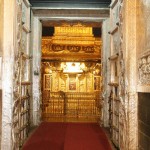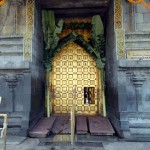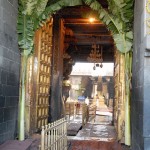DWARAMS OF SRIVARI TEMPLE AT TIRUMALA
The 13th century temple complex of Lord Venkateswara at Tirumala has been extended, renovated and refurbished over several centuries.
The Mahadwaram popularly referred to as the Padi Kavali Maha Dwara or Outer Gopuram stands out as a spectacular specimen of tall structures of all Hindu temple shrines in the country.
Standing on a quadrangular base its architecture belongs to the later Chola period. The grand gopuram comprised of several Tamil inscriptions of the 13th century and speak of the glory of the rulers and the richness of the culture and society of those days.
There are a number of stucco figures of Vaishnava gods like Hanuman, Kevale Narasimha and Lakshmi Narasimha on the gopuram indicating the prevalence of the Vaishnavite cult of worship in the region.
“The TTD has a special wing set up to take care of maintenance and repairs of all the structures in the Main shrine which include several sub temples, Mandapams and Dwarams (Gopurams)” says the Temple Dy.E.O Sri Chinnamgari Ramana.
A dedicated team of 55 personnel headed by an D.E and two assistant engineer take up regular works in the Srivari Temple including all electrical, air conditioning and structural repairs.
The task and enormity of cleaning the main shrine has often raised several challenges as it has to be done as per the Vaikhanasa Agama practices and modern ingredients and utensils are not put to use.
The floors are swept on a regular basis for at least six to eight times a day. Inside the sanctum sanctorum it is cleaned with soft cloth and a broom made of green leaves and grass. Out side also only leaves from shrubs and grass is used to clean the temple.
“Cleaning inside the temple is being done since ages as per Agama practices to retain the divine charm and the unparallel mystic powers of the deity and the temple”, says Sri MG Gopal, Executive Officer of the TTD.
Since the gopuram of the Mahadwaram is exposed to harsh light and heavy winds it is painted with lime soot. Standing in the middle of the Tirumala valley the outer Gopuram and the dwaram were built by the Vijayanagara emperor Srikrishna Devaraya.
Below the Mahadwaram entry is a rock mandapam named after him and also has bronze statues of Sri Krishna Devaraya along with his consorts. All the devotees for darshan of Lord Venkateswara have to pass through this mandapam which housed utilities like Thulabharam etc.
Nadimi Padi Kavali
The Nadimi Padi Kavali or Inner Gopuram is the inner entrance to the temple, which is reached through the Dhvajasthambha Mandapam. Its wooden doors are now silver plated and therefore it is also referred to as the Vendi Vakili.
The doors are smaller than that of the Outer Gopuram and the door is in the middle of the Sampangi prakaram. The prakaram houses several sub temples,Sabera (ward robe of lord), Parakamani (money counting centre).
An elevated wooden ramp sits in the door to facilitate the movement of devotees into the prakaram of the Main shrine. On the gopuram there are numerous inscriptions on the inside walls, the earliest relating to the Pandyan monarch, Jata Varma Sundarapandya of 1251 AD.
Bangaru Vakili ( Golden door )
This is the entrance into the Sanctum Sanctorum of Lord Venkateswara across the Tirumamani Mandapam. There are two tall copper images of the dwarapalakas Jaya and Vijaya on either side of the door. The thick wooden door is covered with gilt plates depicting the dasavataram of Sri Maha Vishnu.
The doorway is directly in line with the Padi Kavali and the Vendi Vakili. It admits pilgrims to the Snapana Mandapam. Suprabhatam is sung in front of this door every day. Not only the doors but also the frontal exteriors and all the pillars of the Mandapam are gold plated.
For all devotees the reflection of gold all around as they enter the mandapam and presented an ecstatic experience. Devotees keep chanting Govinda, Govinda from this point as they inch towards the deity. They are not discouraged even as they are dragged and sent out within seconds of their darshan for which they spend hours in queues and also penance for months.
Commenting on the importantance of the Vendi and Bangaru Vakili Arpita Krishnan, a devotee a software engineer said‘ It is really amazing as when enter these portals we get peace of mind and dissolve ourselves in prayers of Lord Venkateswara
Vaikunta Dwaram :
Vaikunta dwaram is located on the left side of the Main shrine and faces east. This door is opened only on the Day of Vaikunta Ekadasi and Dwadasi i.e only on two days a year.
This Dwaram does not have any special gopuram of its own and is also devoid of any elaborate decorations etc. But the entry into the main shrine through this entry (and not the Bangaru Vakili) is considered as one of the most revered and auspicious achievements for all devotees.
As legend put it entry through door is said to bring some extraordinary blessings of the Lord Venkateswara which were normally meant for the Gods who live in Vaikuntam.
Bangaru Bavi
In front of the Srivari Potu and the Vakula Devi temple on the southern side of the Sampangi Prakaram is a well called the Bangaru Bavi.
The well dug during the Vijayanagara period is also decorated with gold plate and its water is used for all rituals and practices inside the Sanctum though every day water is brought from Akasha Ganga specially for rituals as prescribed in the Agamas.
ISSUED BY THE PUBLIC RELATIONS OFFICER, TTDs, TIRUPATI



